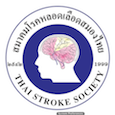Cervical artery dissection
Keywords:
cervical artery dissection, pathogenesis, intramural hematoma, risk factors, antithromboticsAbstract
Cervical artery dissection is an important cause of stroke in young adults. CAD can occur related to trauma or spontaneously. CAD are more likely to occur in the extracranial part of vessel even it can occur in both extracranial and intracranial. The dissections are characterized by separation of the arterial wall between the layers of the intima and media by a haematoma, which may be secondary to an intimal tear or from rupture of the vasa vasorum. Cerebral ischemic is an important complication which result from thromboembolism or hypoperfusion of dissected vessels. Treatment options concern for the secondary prevention have been debated for years due to little randomized trial evidence. Most neurologists favor anticoagulants, but a minority prefer antiplatelets. New evidence of clinical went out but still need more question to resolve
References
Debette S, Leys D. Cervical-artery dissections: predisposing factors, diagnosis, and outcome. The Lancet Neurology 2009;8:668-78.
Debette S, Compter A, Labeyrie MA, et al. Epidemiology, pathophysiology, diagnosis, and management of intracranial artery dissection. The
Lancet Neurology 2015;14:640-54.
Michael Schuenke ES, Udo Schumacher, et al. . Head and Neuroanatomy (THIEME Atlas of Anatomy). first edition ed. Thieme New york: Thieme New york;
2010.
Volker W, Dittrich R, Grewe S, et al. The outer arterial wall layers are primarily affected in spontaneous cervical artery dissection. Neurology
2011;76:1463-71.
Debette S. Pathophysiology and risk factors of cervical artery dissection: what have we learnt from large hospital-based cohorts? Current opinion in
neurology 2014;27:20-8.
Haneline MT, Rosner AL. The etiology of cervical artery dissection. Journal of chiropractic medicine 2007;6:110-20.
Lee VH, Brown RD, Jr., Mandrekar JN, Mokri B. Incidence and outcome of cervical artery dissection: a population-based study. Neurology 2006;67:1809-12.
Engelter ST, Rutgers MP, Hatz F, et al. Intravenous thrombolysis in stroke attributable to cervical artery dissection. Stroke; a journal of cerebral circulation
2009;40:3772-6.
Provenzale JM. MRI and MRA for evaluation of dissection of craniocerebral arteries: lessons from the medical literature. Emergency radiology 2009;16:185-93.
Vertinsky AT, Schwartz NE, Fischbein NJ, Rosenberg J, Albers GW, Zaharchuk G. Comparison of multidetector CT angiography and MR imaging of
cervical artery dissection. AJNR American journal of neuroradiology 2008;29:1753-60.
Leclerc X, Godefroy O, Salhi A, Lucas C, Leys D, Pruvo JP. Helical CT for the diagnosis of extracranial internal carotid artery dissection. Stroke;
a journal of cerebral circulation 1996;27:461-6.
Benninger DH, Georgiadis D, Gandjour J, Baumgartner RW. Accuracy of color duplex ultrasound diagnosis of spontaneous carotid dissection
causing ischemia. Stroke; a journal of cerebral circulation 2006;37:377-81.
Zinkstok SM, Vergouwen MD, Engelter ST, et al. Safety and functional outcome of thrombolysis in dissection-related ischemic stroke: a meta-analysis
of individual patient data. Stroke; a journal of cerebral circulation 2011;42:2515-20.
Broderick JP, Palesch YY, Demchuk AM, et al. Endovascular therapy after intravenous t-PA versus t-PA alone for stroke. The New England journal of
medicine 2013;368:893-903.
Kernan WN, Ovbiagele B, Black HR, et al. Guidelines for the prevention of stroke in patients with stroke and transient ischemic attack: a guideline for
healthcare professionals from the American Heart Association/American Stroke Association. Stroke; a journal of cerebral circulation 2014;45:2160-236.
Group ES, Halkes PH, van Gijn J, Kappelle LJ, Koudstaal PJ, Algra A. Medium intensity oral anticoagulants versus aspirin after cerebral ischaemia
of arterial origin (ESPRIT): a randomised controlled trial. The Lancet Neurology 2007;6:115-24.
Chowdhury MM, Sabbagh CN, Jackson D, Coughlin PA, Ghosh J. Antithrombotic treatment for acute extracranial carotid artery dissections: a meta-analysis. European journal of vascular and endovascular surgery: the official journal of the European Society for Vascular Surgery 2015;50:148-56.
Sarikaya H, da Costa BR, Baumgartner RW, et al. Antiplatelets versus anticoagulants for the treatment of cervical artery dissection: Bayesian meta-analysis. PloS one 2013;8:e72697.
investigators Ct, Markus HS, Hayter E, et al. Antiplatelet treatment compared with anticoagulation treatment for cervical artery dissection (CADISS):
a randomised trial. The Lancet Neurology 2015;14: 361-7.
Nedeltchev K, Bickel S, Arnold M, et al. R2-recanalization of spontaneous carotid artery dissection. Stroke; a journal of cerebral circulation 2009;40:
499-504.
Pham MH, Rahme RJ, Arnaout O, et al. Endovascular stenting of extracranial carotid and vertebral artery dissections: a systematic review of the literature.
Neurosurgery 2011;68:856-66; discussion 66.
Donas KP, Mayer D, Guber I, Baumgartner R, Genoni M, Lachat M. Endovascular repair of extracranial carotid artery dissection: current status and level of evidence. Journal of vascular and interventional radiology : JVIR 2008;19:1693-8.
Edgell RC, Abou-Chebl A, Yadav JS. Endovascular management of spontaneous carotid artery dissection. Journal of vascular surgery 2005;42: 854-60; discussion 60.
Mizutani T, Aruga T, Kirino T, Miki Y, Saito I, Tsuchida T. Recurrent subarachnoid hemorrhage from untreated ruptured vertebrobasilar dissecting aneurysms. Neurosurgery 1995;36:905-11; discussion 12-3.
Chiche L, Praquin B, Koskas F, Kieffer E. Spontaneous dissection of the extracranial vertebral artery: indications and long-term outcome of surgical
treatment. Annals of vascular surgery 2005;19:5-10.
Muller BT, Luther B, Hort W, Neumann-Haefelin T, Aulich A, Sandmann W. Surgical treatment of 50 carotid dissections: indications and results. Journal of
vascular surgery 2000;31:980-8.
Lansberg MG, O’Donnell MJ, Khatri P, et al. Antithrombotic and thrombolytic therapy for ischemic stroke: Antithrombotic Therapy and Prevention of Thrombosis, 9th ed: American College of Chest Physicians Evidence-Based Clinical Practice Guidelines. Chest 2012;141:e601S-36S.
Guillon B, Levy C, Bousser MG. Internal carotid artery dissection: an update. Journal of the neurological sciences 1998;153:146-58.
Guillon B, Brunereau L, Biousse V, Djouhri H, Levy C, Bousser MG. Long-term follow-up of aneurysms developed during extracranial internal carotid artery
dissection. Neurology 1999;53:117-22.
Downloads
Published
How to Cite
Issue
Section
License
ข้อความภายในบทความที่ตีพิมพ์ในวารสารสมาคมโรคหลอดเลือดสมองไทยเล่มนี้ ตลอดจนความรับผิดชอบด้านเนื้อหาและการตรวจร่างบทความเป็นของผู้นิพนธ์ ไม่เกี่ยวข้องกับกองบรรณาธิการแต่อย่างใด การนำเนื้อหา ข้อความหรือข้อคิดเห็นของบทความไปเผยแพร่ ต้องได้รับอนุญาตจากกองบรรณาธิการอย่างเป็นลายลักษณ์อักษร ผลงานที่ได้รับการตีพิมพ์ในวารสารเล่มนี้ถือเป็นลิขสิทธิ์ของวารสาร





